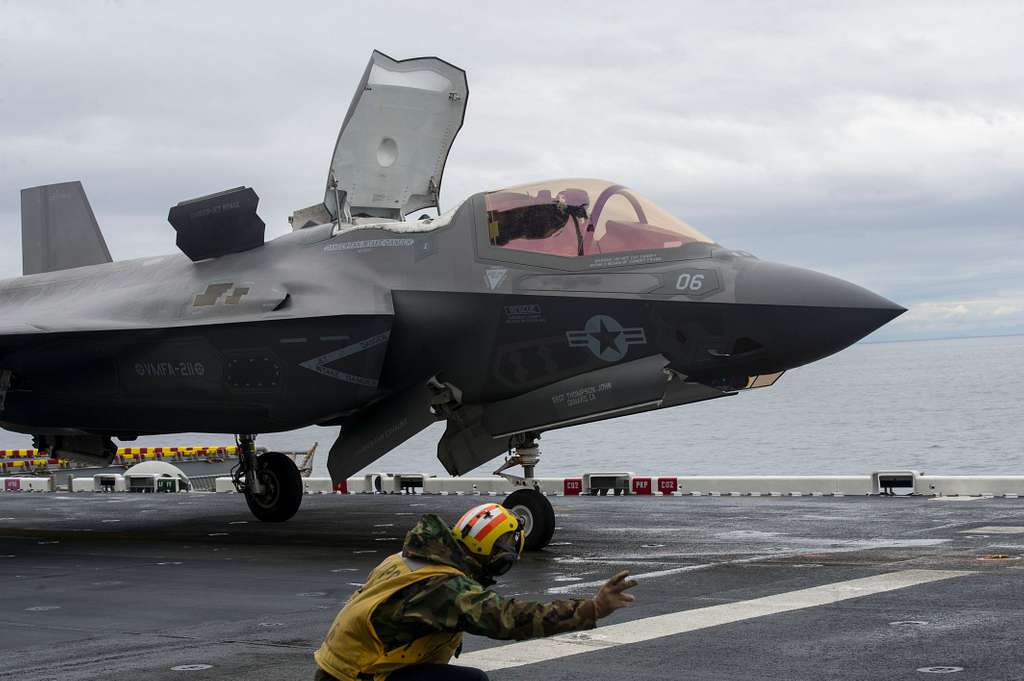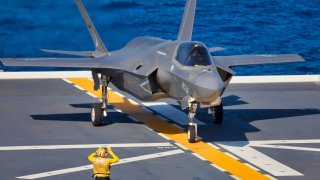This USMC F-35 Lighting II Squadron Is Now at Full Operational Capability
The F-35B features S/VTOL capability, allowing the Lightning II variant to operate from amphibious assault ships and expeditionary airstrips less than 2,000 feet long.
The first United States Marine Corps squadron has achieved full operational capability with the fifth-generation Lockheed Martin F-35 Lightning II stealth fighter. Marine Fighter Attack Squadron (VMFA) 542, 2nd Marine Aircraft Wing (MAW), announced that it has become the U.S. Marine Corps’ first East Coast F-35 Lightning II squadron in the Fleet Marine Force.
VMFA-542 has completed its transition from a legacy tactical-aircraft platform to the F-35B Lightning II—the short/vertical takeoff and landing (S/VTOL) of the Joint Strike Fighter—and its full operational capability means that is ready and capable for full operations and deployment globally with the advanced aircraft. That includes in support of planned or contingency operations.
As 2nd MAW’s first operational fifth-generation fighter-attack squadron, the unit can fulfill its mission essential tasks (METs) in support of the Marine Air-Ground Task Force (MAGTF)—which includes close-air support, strike, strike coordination and reconnaissance, offensive anti-air warfare, suppression of enemy air defenses, electronic attack, electronic support, and active air defense.
“Achieving full operational capability is a testament to the exceptional hard work and professionalism from the Marines of VMFA-542,” said Lt. Col. Brian Hansell, commanding officer of VMFA-542. “This milestone marks the addition of a battle-ready aviation squadron with unmatched combat lethality and survivability to the Marine Expeditionary Force. We are ready and able to conduct missions globally in support of the MAGTF as we continue to prepare for the next challenge.”
Transition Completed
VMFA-542 began the transition to the F-35B Lightning II in December 2022, and the squadron received its first F-35B on May 31, 2023. The unit achieved initial operational capability on Feb. 5 before receiving its tenth aircraft on March 25 and achieving full operational capability on April 3.
The squadron recently participated in Exercise Nordic Response 24 in Norway with NATO allies and partners, demonstrating military prowess across the land, maritime, and aviation domains against challenging arctic and mountainous conditions. During the exercise, VMFA-542 conducted a distributed aviation operations event at Kallax Air Base in Lulea, Sweden, on March 13, marking the first time a U.S. F-35 Lightning II aircraft landed in Sweden, the first time any F-35 operated at Kallax Air Base, and one of the first training events conducted by Sweden as a NATO member.
It demonstrated the United States’ commitment to NATO and its readiness to operate in challenging environments, strengthening interoperability among allies.
The USMC Loves the F-35
As the most mechanically complex of the three F-35 models, the F-35B features S/VTOL capability, allowing the Lightning II variant to operate from amphibious assault ships and expeditionary airstrips less than 2,000 feet long.

According to the platform’s manufacturer, Lockheed Martin, “STOVL operation is made possible through the patented shaft-driven LiftFan propulsion system. This propulsion approach overcomes many of the temperature, velocity and power challenges of direct-lift systems.”
Due to its lifting fan position, the F-35B has less internal storage capacity than its counterparts.
However, as with the F-35A and F-35C models, the F-35B can operate in “stealth” configuration and it can still carry four Aim-120 AMRAAM missiles for air-to-air missions or a combination of four AIM-120/GBU-31 JDAM smart bombs for air-to-ground missions. The F-35B also can enter “beast mode,” which enables the platform to carry up to fourteen AIM-120 missiles for ground operations, two AIM-9x missiles for air-to-air missions, or four Aim-120/9X missions coupled with six GBU-31s.
Author Experience and Expertise
Peter Suciu is a Michigan-based writer. He has contributed to more than four dozen magazines, newspapers, and websites with over 3,200 published pieces over a twenty-year career in journalism. He regularly writes about military hardware, firearms history, cybersecurity, politics, and international affairs. Peter is also a Contributing Writer for Forbes and Clearance Jobs. You can follow him on Twitter: @PeterSuciu. You can email the author: [email protected]


